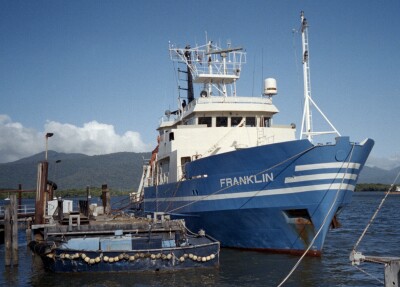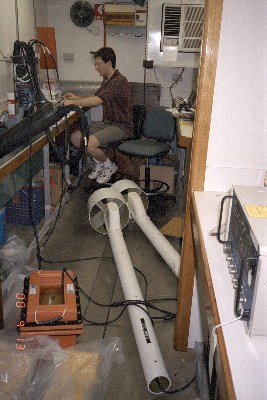The CSIRO
days.
1999-2002.

Voyage
of discovery by the RV Franklin
When I applied for a 3 year position with the “Mining
Automation group” at CSIRO
QCAT (Queensland centre for advanced technology) in November
of 1999 they were in urgent need of someone to design PCB and
create wiring diagrams for an urgent project.
The project was
to make a package for doing geo-physical recording at a depth of
2000 meters in the Bismarck Sea. There was a trip planned the
following April which was mainly hunting for "extremophile"
microbes with our stuff hitching a ride. The ship used for the
trip was the CSIRO research vessel R.V
Franklin.
After an informal cooks tour of QCAT I left QUT
and was employed as casual and then later given the three year
contract I was originally after. With four months left to drop our
bundle into the Bismarck things were busy. The overall design was
no where near finalized. The original wish list was whittled down
to reality. At one point a power budget showed it would not work.
One PC (of two) was removed from the design, sample rates reduced
and other compromises made. I looked after the overall wiring
diagrams, made interconnection boards and also worked on a
electronics for a towed electrode array, will allow induced
polarisation (IP), resistivity and impedance measurements. Two of
us drove the gear from Brisbane to Cairns and I helped debug the
system on the ship. Five of us from QCAT were there but only two
were going on the trip – I get sea-sick so I was happy to be
left behind.
 In
a nut-shell we had two pressure vessels. One was for power
supplies of which there were plenty and the other housed a PC104
stack, the towed array drivers and some stuff I probably shouldn't
talk about. We didn't get the chirp sonar till a few days before
the gear left QCAT (a surprise – it was much bigger and
heavier than we imagined). We didn't see the magnetometers until
on the ship a few days before the ship sailed.
In
a nut-shell we had two pressure vessels. One was for power
supplies of which there were plenty and the other housed a PC104
stack, the towed array drivers and some stuff I probably shouldn't
talk about. We didn't get the chirp sonar till a few days before
the gear left QCAT (a surprise – it was much bigger and
heavier than we imagined). We didn't see the magnetometers until
on the ship a few days before the ship sailed.
 Right
- Jonno is debugging the software on board the ship a day or two
before she sails. The PC104 tube is in front on him. The power
supply tube is at 45 degs sitting in the sink, the white tubes on
the floor are magnetometers and the orange thing is a deep-sea
battery.
Right
- Jonno is debugging the software on board the ship a day or two
before she sails. The PC104 tube is in front on him. The power
supply tube is at 45 degs sitting in the sink, the white tubes on
the floor are magnetometers and the orange thing is a deep-sea
battery.
Left – Yours truly helping Jonno check the wiring after we did a rebuild to replace a faulty data acquisition board on the night before departure.
All in all things worked, a few things fell over but
considering we had no testing to speak of - we did well - see
http://www.spacedaily.com/news/life-00zc.html
CRUISE
SUMMARY RV FRANKLIN FR 03/2000 Title BINATANG 2000
The
chirp idea was intriguing so I later wrote a chirp
program for the PC.
Highwall mining.
After the
undersea stuff it was back to normal in the automation group this
means coal. I was put to work on the mk3 (improved mk2) Highwall
mining project. Highwall mining for those who don't know is one of
many mining methods for digging up coal. When coal is near the
surface it is usually mined using an “open-cut”
method. This is abandoned when the seam is covered with too much
dirt. What is left to a highwall with a seam at the bottom. Some
underground mining method can then be used but it setup cost is
high. An alternative is to dig out more of the seam with a
remotely operated machine. As no people go underground no roof
support is used. This is generally not a problem unless the tunnel
come too close together or cross. To guide the miner (machine)
accurately the mk3 uses high accuracy military grade inertial
sensors (aka INS or HORTA). My job was to shoehorn two pc104
boards into a panel-PC by making an adapter. This worked. I also
made an interface for the odometer which measured the distance the
mining had traveled. The INS uses an SDLC interface, four wires
were used to send INS commands and data from the control cabin to
the INS in the miner.
I was working on a control system to turn
the INS on and off remotely when I stated that it would be easier
to build a protocol converter than do it the way we were.
This
generated strange looks.
People had spent years trying to do
just that and failed. I was told I could look into it –
about a week later I demonstrated I could speak SDLC to a INS (aka
HORTA talk). I used a AVR2313, no SDLC controller chip, all
signals were software generated.
This generated deeply
thoughtful looks.
A few days later the original MK3 work I was
doing was shelved and my protocol convert became the nerves of the
MK3.
http://www.appliedminingtech.com/mk3tour.html
Note
that I did not write the PC GUI. I wrote PC diagnostic software
but not the end-user interface.
The original system used 4 wire for
comms another one or two for power switching. Each wire goes
through a slip ring so fewer wires is very good. The original
system had comms to the INS but nothing else.
My system used 2
wire RS485 for everything. It worked at 115 K Baud - three times
the speed of the MK2. It was tested through a 1000 meter cable
with safety barriers fitted. These interfaces usually need to be
I.S.(intrinsically safe) for explosive atmospheres, this means
current and voltage clamps.
I wrapped the INS packets in my
own protocol so we could talk to the protocol converter as well as
INS. It took another eight months to fully develop the system. It
did everything originally planned plus remote battery monitoring
and some autonomous power management by the converter.
After
commercialization I continued to upgrade the MK3
hardware/firmware. Dual gamma counters and dual inclinometers were
added.
There then were a bunch of small jobs I won't go into in any detail. Mainly these were either for the “rapid roadway development” project or the “landmark” longwall mining automation project.
http://www.dem.csiro.au/mining_automation/research/projects/longwall/
http://www.umwa.org/mining/unequip.shtml
http://www.dem.csiro.au/mining_automation/research/projects/rapidroadway/
More wiring diagrams, a video switcher, watchdog timer and another interesting project –
Laser scanner ethernet interface.
The
RRDs autonomous conveying-bolting module (ACBM)
incorporates several ranging lasers scanners (made by SICK). When
running in continuous scan mode (>30 scans/sec) serial data
streams out at 500Kbaud minimum. This is non-standard data rate,
for setup purposes we also need 9600. This is pain for PCs but not
for micro-controllers. I made a serial to ethernet (10BaseT)
converter based on the crystal LAN etherent controller CS8900a and
a AVR8515. It took a while to find all the bugs but eventually it
was solid.
I was also part of the Numbat team but it was never used in anger, I took it for a walk a few times.